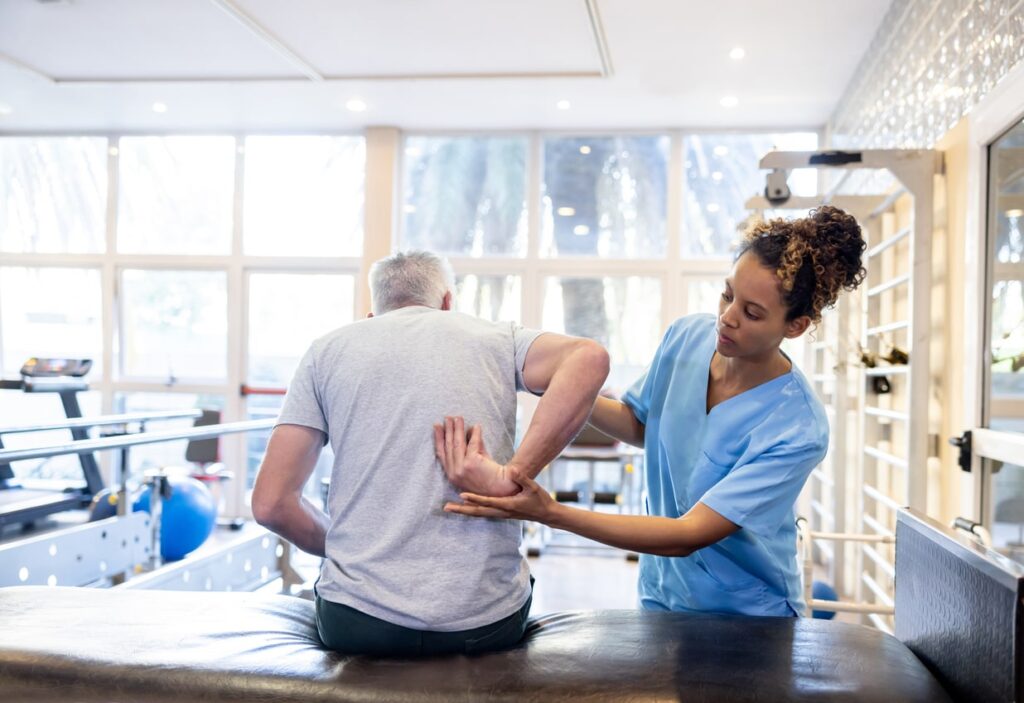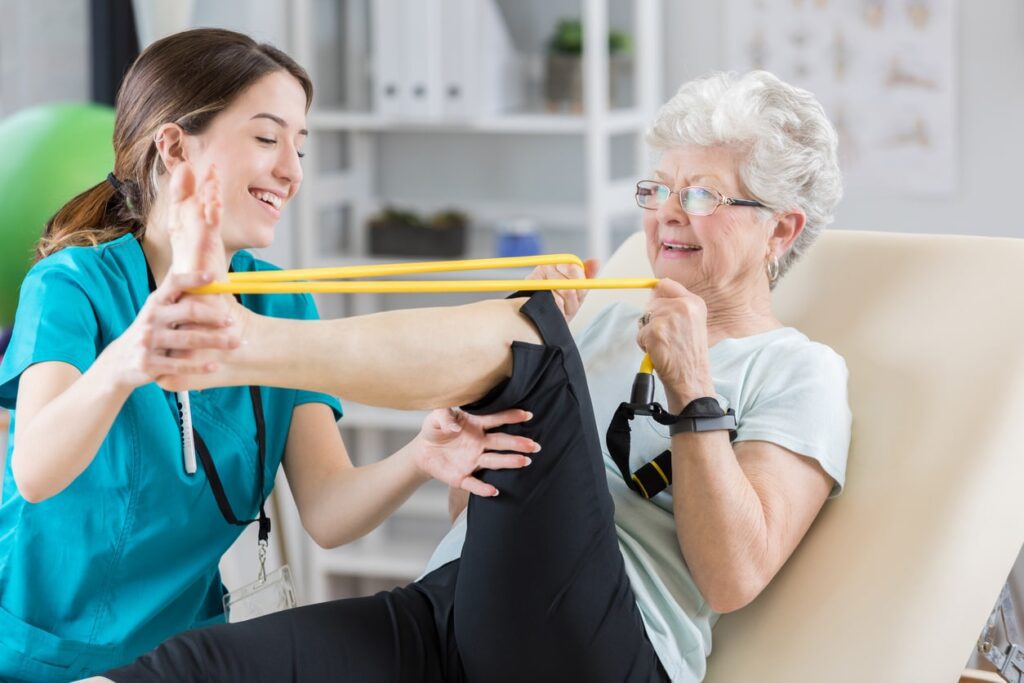Physiotherapy is an excellent way to make movement easier – while the treatments are commonly associated with healing and recovery, many healthy people also have regular physiotherapy treatments for a range of reasons. In fact, your favourite athletes are probably undergoing some form of physiotherapy treatment to stay at the top of their game. With such versatile use, almost anybody can benefit from physiotherapy in their day-to-day lives, including you.
At Get Moving Physio, we have been offering a range of physiotherapy treatments in Bolton and the surrounding areas, and our team is well versed in providing a top notch service. It always surprises us when our customers have come to us with assumptions about their treatment, only to have their eyes opened to exactly how physiotherapy works. In this article, our team has come together to create a deep dive exploration into some of the more common physiotherapy treatments available, and what they can do for you.

Debunking Physiotherapy Myths
Before we begin, let’s explore some of the common myths that circulate about physiotherapy that can put a lot of people off seeking this line of treatment. The internet is full of incorrect information, so we encourage you to only trust reliable sources when seeking facts about physiotherapy – in fact, you can reach out to our team today to have a chat to find out more. Let’s start with our first myth:
Physiotherapy is Expensive and Time Consuming
As with any long term treatment method, physiotherapy does require some investment of time and money to achieve results, but in the long term can help you avoid treatments that can be a lot more expensive and time consuming to recover from – like surgery.
Physiotherapy is Uncomfortable and Painful
We’ll admit, sometimes there is some discomfort or soreness during and after your physiotherapy appointment, but it shouldn’t be excessively painful. For comparison, you’ll probably feel like you’ve finished a good, active strength session at the gym.
Physiotherapy is Only for Elderly People or Chronic Conditions
Absolutely not. While physiotherapy can certainly help with movement and soreness, it’s not exclusively a treatment for those with chronic conditions or those who are a little longer in the tooth. Physiotherapy can treat a range of issues, including back pain, knee pain, and sports related injuries.
Physiotherapy Has Only One Approach
We wouldn’t be writing this article today if this was true. Physiotherapy is highly versatile and designed to be altered to suit the individual – there is no one-size fits all approach when it comes to physiotherapy. When you choose Get Moving Physio, you get a personalised approach to your treatment.

Now that we’ve jumped into some of the myths about physiotherapy, we hope to have either opened your mind to the concept of this treatment, or have provided you with some useful information on some of the misconceptions out there. Now, let’s take a closer look at the most common physiotherapy treatments and explore what they target, and how a specific treatments helps a certain condition, starting with:
Soft Tissue Manipulation
Used to describe different forms of massage therapy, soft tissue manipulation is a manual therapy which massages different muscles in order to promote healing and break down any scar tissue. It works by mobilising the muscles to remove waste products from the affected area while also releasing tension in the muscle, which could help increase flexibility and overall range of movement. There are many conditions that can be treated with soft tissue manipulation, including:
- Carpal tunnel syndrome
- Arthritis
- Whiplash
- Muscle injuries/spasm
- Sciatica
- Fibromyalgia
- Contractures
- Scar tissue
While some soft tissue manipulation can be uncomfortable, especially in very tight or deep structures, the benefits are undeniable. If you’re worried about discomfort, let your physiotherapist know and they will be able to proceed with your treatment to a level that you are comfortable with, and will never perform any treatments without your express consent.
Ultrasound Therapy
A relatively new treatment option for physiotherapy, when you think of an ultrasound, you may think of expectant mothers seeing their babies for the first time. But an ultrasound device is more than just a tool for diagnosing, it can also be used to treat. The ultrasound frequency creates sound waves which stimulate the ligaments, muscles, and tendons, which is then absorbed. This method of physiotherapy is typically used to treat pain in joints and muscles, and can benefit those dealing with:
- Neck pain
- Chronic back pain
- Bone cancer
- Tendinitis
- Myofascial pain
- Nerve pain
- Bursitis
- Osteoarthritis
It’s important to keep in mind that there are some limitations to ultrasound therapy, and it isn’t a suitable treatment option for everyone. For example, if you are pregnant, have a pacemaker, broken bones, or cancerous tumours or medical implants in the treatment, this is not the treatment for you. Don’t worry though, our experts at Get Moving Physio can offer an alternative treatment, just get in touch to discuss your needs.
Range of Motion Exercises
While recovering from a broken bone or surgery, or you’ve had extended periods of immobility, you may be recommended physiotherapy focusing on range of motion (ROM) exercises. This is possibly what most people picture when they think of physiotherapy – using physiotherapist assisted exercises to promote movement, allow better circulation, and encourage mobility in stiff or sore joints. Some of the conditions ROM exercises can help include:
- Post joint surgery
- Acute injury with swelling
- Muscle strain
- Arthritic pain
- Ligament sprains
- Post joint replacement
ROM exercise can also be prescribed pre-surgery to limit loss of movement after surgery, where it will be much more difficult to perform ROM exercises while recovering and in pain. There are a few different types of ROM exercises and each have a specific purpose, this includes Active Range of Motion (AROM), Passive Range of Motion (PROM), and Active Assisted Range of Motion (AAROM). For more information on each of these types of range of motion exercise, or any other form of physiotherapy we offer at Get Moving Physio, get in touch with our team today.
How Does Get Moving Physio Use Physiotherapy?
At Get Moving Physio, we provide a huge range of physiotherapy services, but our team have narrowed down our most popular treatment options into informative and easy to read chunks for you to digest. See something that grabs your attention and you believe may benefit you or a loved one, reach out to Get Moving Physio for more information. Our most popular treatments include:
Fall Prevention
As we age, trips and tumbles can become more and more common, and unfortunately our bodies become less and less able to absorb these impacts safely. There are many ways physiotherapy can help with this. First off, we will do an examination of your balance, range of movement, joint mobility, and gait when walking to create an effective treatment plan tailored just to you. The goal will be to improve your overall strength, balance, and mobility to minimise the risk of falls, but also minimise the consequences of a fall. We will also teach you how to safely get up off the floor and will ensure your living environment is as safe as it can be.
Frailty Therapy
When we get older, we sometimes find that it’s harder to do certain things than it used to be, but our frailty services can help keep some normalcy in your life with comprehensive strength, balance, and mobility treatments. When you choose our service, you will be guided with strength and resistance training, balance and coordination exercises, and functional mobility training to support both your independence and quality of life. We can also assess you for assistive devices like walkers or canes and ensure a proper fitting for comfort – further supporting your independence in the long term.
Sports Massage Therapy
Contrary to the name, sports therapy is for more than just athletes and has many functional benefits to improve your day-to-day life. At Get Moving Physio, our sports massage therapy services can be used to address injuries and rehabilitate to encourage a better performance. We do more than just treat the issue, though. We also strive to educate you on injury prevention and guide you through the steps you can take to limit your risk, either daily or as a professional athlete. If you are an athlete, returning to your sport after an injury may seem daunting, so we even offer a service to help with that too! Reach out for more information now.
Contact Get Moving Physio to find out more!
To find out more, or to enquire about any of the services we’ve covered in this article, get in touch with Get Moving Physio now. We offer a huge range of services, so many that we haven’t even mentioned some of them – like our 3D orthotic printing service. Contact us for more information!








